QuestionI just bought a new leopard gecko, this is my first time owning a lizard so I am kind of nervous as to how to keep him safe. So if you done mind I have a few questions in regards to living conditions.
For housing he has a 20g tank, red sand, a cut out log home purchased at the pet value store, he has a claimable rock, sticks, and an artificial plant, as well there is a tiny size cap lid with water. Is this ok?
I heard for a water source you are spouse to be spraying the leaves with a squirt bottle for them to drink, is this true?.
For now the hiding log is in the center of the tank, right to the back of the tank, and the light if off to the side. Should his hiding log be placed directly under the lamp?
I am using a desktop lamp with a 23 W bulb directly over the corner of the tank. I have a stick on temp reader, right under the light, but I am getting no reading. I also have another temperature reader on the other side and it is reading 70. Do I need a higher wattage?
I have purchased crickets, and they are being stored in a small plastic fish tank with the egg holder container in the tank,I have given them, a soaked sponge, and a few slices of potatoes is this ok? and how owten do i re wet the sponge?
I grabbed a container of reptile calcium with D3. What is the procedure for cleaning the crickets before feeding?
Thank you, this will be greatly appreciated.
AnswerHi Chris,
Congrats on your new gecko! They are very interesting lizards!! I am including a basic care sheet that I wrote to help people out. Feel free to print it out so you can refer to it often.
First, remove the sand.... it is deadly to geckos. Even if the sand says that it is edible, believe me, its not. In the care sheet below is a link to what happens to geckos kept on sand. There are also ideas as to safe things to use on the floor of the tank.
Great on the size tank you are using!!!
For water, as he grows, you will want to increase the size of the container you are using. Some leos do decide to soak in their water so the dish needs to be shallow but large enough for them to get into if they want. You don't want to get his tank too wet with misting as too much humidity isn't good for the leo. When he is out and about you can mist a plant or the side of the tank in one area to see if he will lick at the water drops.
The stick on thermometers really are not accurate. I like the digital ones with the probe on the end of a wire.
Basically, think of his tank as being divided into 3 sections. A warm, a medium zone and a cool zone. Its best to have a hide in the middle zone and the warm zone. The warm zone should have an under tank heater. You want that to cover just 1/3 of the tank. You also want a humid hide..generally on the warm end of the tank.
As to the wattage you need to use, thats tough to say as that there are many factors to consider...room temperatures, near windows? outside walls? where you live..etc.. For my leos, I use a 60 watt heat emitter, an undertank heater and for daytime I have a low uvb output fluorescent tube that is 18 inches long.
As to your crickets.. the potato will provide water for them..and the sponge is fine also.You can re-wet the sponge when it is dry.
You do want to offer the crickets more food though...if the crickets are not fed nutritious foods, your gecko doesn't get the needed nutrition. You always want to gut load(feed) the crickets at least 24 hours before offering them to your leo. Give the crickets uncooked oatmeal, no sugar cereals, fruits, dark leafy veggies, carrots, and you can also offer them chicken laying mash if you have access to that! You really don't have to clean the crickets before feeding them to your leo..you just need to feed the crickets a nutritious diet.
BASIC CARE FOR A LEOPARD GECKO
Leopards are pretty easy to care for but they do need
special care. Here are some of the basic needs of your gecko.
HOUSING: The need to have at least a 20 gallon long tank for one Leo. This needs to have a secure fitting screen top...they can be quite the escape artists!!! They need to have a humid hide box.You can make this with something as simple as a small plastic dish with a hole cut in one side and a small mesh bag filled with some Sphagnum moss coconut bark or Peat moss that you mist.
I made mine out of the small plastic folgers coffee containers...I cut an opening in the lid..and put the moss in..they LOVE it. I use the terrarium moss in mine.
I use that on the warm side of the tank. Be sure to provide a cool hidebox on the other end. I also provide a mid temperature hide...which is in the middle of the tank.I use the critter caves which you can purchase. NOT the ones that have heat in them!!!!
Provide secure climbing areas for your gecko. Fake plants, rocks and branches are all fine to use. be sure there are no wires or sharp ends to any fake plants you use.
*****SUBSTRATE:(that's the stuff on the floor of your tank) Newspaper, lizard carpet or paper towels work great and are easy to clean and are much safer than any loose substrate. Sand or other loose substrate is not recommended as that they can be deadly to the leo when it is ingested(eaten, even by accident while eating their insects)...A very graphic site of an impacted leo surg can be seen at http://homepage.mac.com/exoticdvm/reptile/PhotoAlbum181.html it is very graphic!!! ******What I have found that works great for safety and heat distribution is using about 1/4 inch of childrens play sand(since the tiles fit tight together, there is no sand danger) on the bottom of the tank and on top that you place ceramic or slate floor tile. What is nice is that the 12 x 12 squares fit perfect in a 20 gallon tank with no spaces between the tiles. The sand and the tile distribute the heat wonderfully. Using the under tank heater as described is what distributes the heat. Also, overhead heat will help in heating the tiles...I've been using this set up for several years and the leos love it. Using a tile that isn't smooth is recommended. **********
TEMPERATURES: They need a warm area ( on the floor) of 88-92 degrees and a
cooler area in the upper 70s, low 80s. At night their temperature can drop to the low to mid 70's.
Never use a hot rock for a leopard gecko...or any reptile.
They can severely burn any reptile. You can use a heating
pad under the tank,under tank heater for the warm area. You can use a regular household lightbulb in a dome fixture with a ceramic socket in it to keep the warm area at the 88-92 degree area if needed there, otherwise, placing the lightbulb about midway in the tank will give the needed temeratures throughout the tank. You may have to play with the wattage of the bulb but generally 40-60 watts is sufficient.At night, no white light. If room temperatures stay above 70 degrees, no extra night heat is needed. The undertank heater or heating pad should cover about 1/3 of the tank....be sure to raise the tank up about 1/4-1/2 inch off the stand when using an undertank heat source to prevent heat build up which can cause the glass to break and hot spots in the glass. Be sure to have a good layer of newspaper, carpeting or, even a thin flat rock(such as tile) on top the area that the undertank heat source is placed...if you use a thin rock or tile, it helps to distribute the heat very well.
You can use the special nighttime lights that are designed for reptiles. I like using a ceramic heat emitter on a thermostat for nighttime heat.
DO NOT use black lights or party lights as they can cause eye damage!!!!
The wattage you use will vary based on room temperature and size of tank.
LIGHTING: Leopard geckos do not need UVB lighting but it does not hurt them to give them uvb. They should have some type of light during the day, be it a uvb tube, regular florescent light, reptile day light or regular household lightbulb. NO white lights at night!!!
FEEDING: Geckos should not be fed crickets or other insects that are bigger than the space between their eyes. Generally, hatchlings can be fed more than once a day,juvys can be fed twice a day, adults are fed once daily or every other day, in the early evening. Crickets and other food items such as silk worms, super, and an occasional treat of a wax worm, need to be dusted with a calcium supplement two times a week and also they should have a small dish of calcium in their tank. I use the lid of a milk jug for the little dish of calcium in their tank. For dusting the insects, Use a calcium with no added phosphorus. Insects must be gut loaded(fed) for at least 48 hours prior to feeding your gecko. Remove any uneaten crix or superworms after 15-20 minutes..... Place a piece of cut potato in the tank so that if you have missed any uneaten insects, they will eat the potato instead of nibbling on your gecko!!!
*************You have to be sure to feed your crickets and insects the right foods before feeding them to your gecko. If your crickets/insects are not healthy and well fed, your gecko will not get the nutrition he needs. You can gut load your crickets and insects greens, veggies, cereals or specially designed commercial foods for crickets or the insects you are feeding. ************
Be sure to have a small dish of clean water for your gecko at all times!!
You can offer them some baby food or fruits on occasion ...
Mine will even eat a small piece of watermelon now and then.WATER: always provide a dish of drinking water. If you choose to mist your gecko to drink, its best to not get the tank too wet as that they do not do well with higher humidity. Sometimes its better to take your leo out of their tank to mist them to get them to drink!!!
HANDLING: Some geckos enjoy being held...others prefer not to be handled at all. Be sure to be very gentle when holding your leo and NEVER grab them by the tail! Their tails are extremely fragile and will break.
I do suggest finding a vet that can treat reptiles BEFORE you actually need one!!! To find a vet that is able to care for reptiles:
http://www.herpvetconnection.com
http://www.arav.org/ECOMARAV/timssnet/amm/tnt_mdsearch.cfm
http://www.anapsid.org/vets/
For more information on leopard geckos:
http://www.drgecko.com
If you have any questions or don't understand something, please let me know.

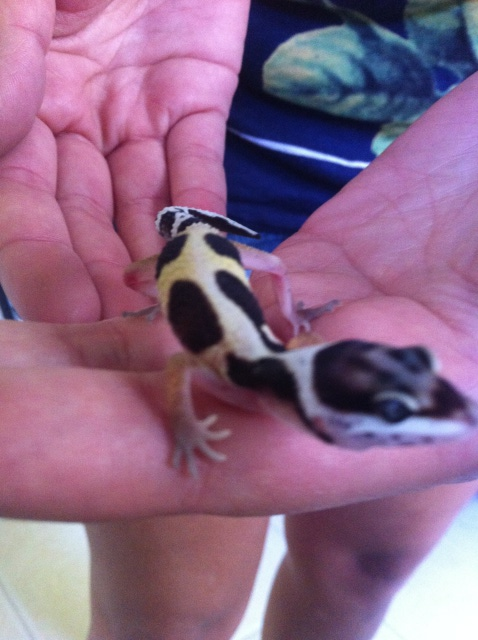 hatchling leopard gecko
Question
Salem
Hello Donna,
I am contacting you
hatchling leopard gecko
Question
Salem
Hello Donna,
I am contacting you
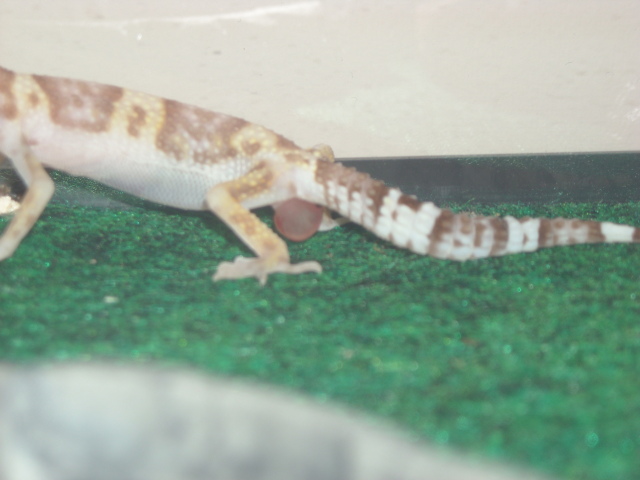 Worried About Leopard Gecko
Question
Yoshis problem
Hi, Yexalen
I have a juvenile
Worried About Leopard Gecko
Question
Yoshis problem
Hi, Yexalen
I have a juvenile
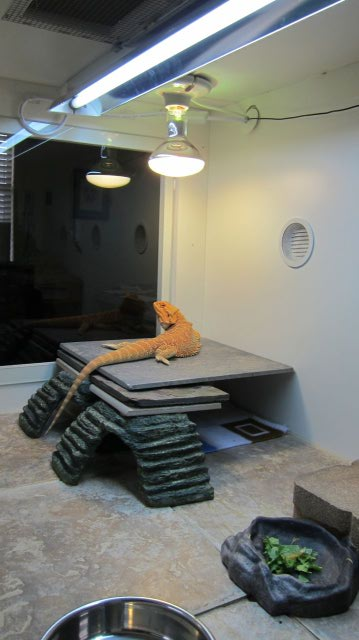 Pics of viv with Arcadia T-5 D3 12% and PowerSun Mecury Vapor Bulb
Question
Hot Side Cool Side
Hi Tracie!!
As
Pics of viv with Arcadia T-5 D3 12% and PowerSun Mecury Vapor Bulb
Question
Hot Side Cool Side
Hi Tracie!!
As
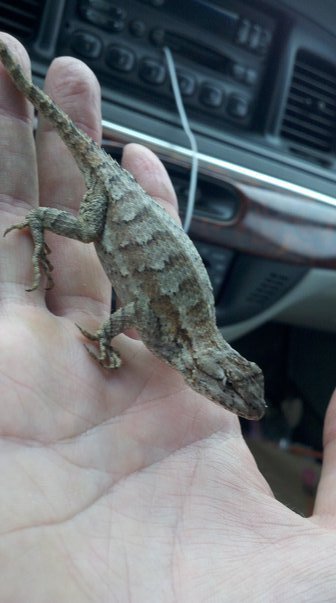 Texas Spiny lizard?
QuestionTexas Spiny Lizard?
QUESTION: My son fou
Texas Spiny lizard?
QuestionTexas Spiny Lizard?
QUESTION: My son fou
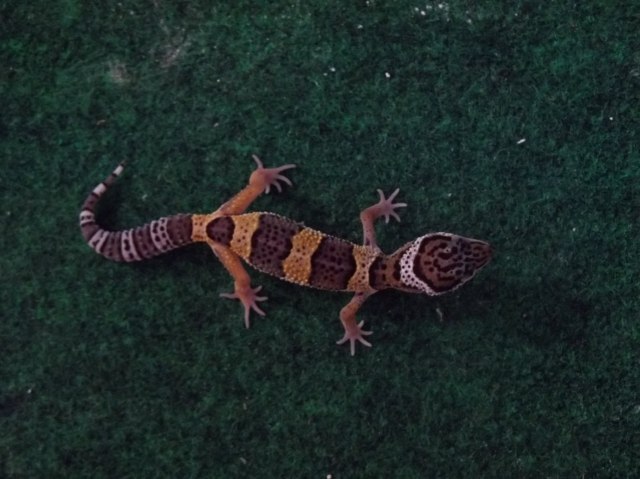 Feeder size for my leopard gecko
Question
My Leo
I have a juvenile leopard gecko thats a
Feeder size for my leopard gecko
Question
My Leo
I have a juvenile leopard gecko thats a